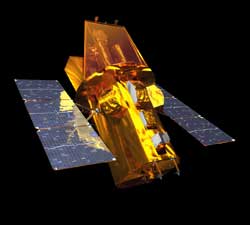The Neil Gehrels Swift Observatory
 Gamma-ray bursts (GRBs) are the most powerful explosions the Universe has seen since the Big Bang. They occur approximately once per day and are brief, but intense, flashes of gamma radiation. They come from all different directions of the sky and last from a few milliseconds to a few hundred seconds. So far scientists do not know what causes them. Do they signal the birth of a black hole in a massive stellar explosion? Are they the product of the collision of two neutron stars? Or is it some other exotic phenomenon that causes these bursts?
Gamma-ray bursts (GRBs) are the most powerful explosions the Universe has seen since the Big Bang. They occur approximately once per day and are brief, but intense, flashes of gamma radiation. They come from all different directions of the sky and last from a few milliseconds to a few hundred seconds. So far scientists do not know what causes them. Do they signal the birth of a black hole in a massive stellar explosion? Are they the product of the collision of two neutron stars? Or is it some other exotic phenomenon that causes these bursts?
With Swift, a NASA mission with international participation, scientists have a tool dedicated to answering these questions and solving the gamma-ray burst mystery. Its three instruments give scientists the ability to scrutinize gamma-ray bursts like never before. Within seconds of detecting a burst, Swift relays its location to ground stations, allowing both ground-based and space-based telescopes around the world the opportunity to observe the burst's afterglow. Swift is part of NASA's medium explorer (MIDEX) program and was launched into a low-Earth orbit on a Delta 7320 rocket on November 20, 2004. The Principal Investigator is Dr. Brad Cenko (NASA-GSFC).
» NASA Release
» En Espanol
» Multimedia
Swift Operations Status
Operations are nominal.
Swift Resources
» GRB, BA, & TOO Contact Information» BAT Transient Lightcurves
» Swift Supernovae
» Observing Schedule
» Journal Papers Related to Swift
» Swift Press Release Image Archive
» Swift Mission Participants
Latest Swift GRBs
Latest Swift News
NASA Awards Company to Attempt Swift Spacecraft Orbit Boost
Sep 24, 2025
Driving rapid innovation in the American space industry, NASA has awarded Katalyst Space Technologies of Flagstaff, Arizona, a contract to raise a spacecraft’s orbit. Katalyst’s robotic servicing spacecraft will rendezvous with NASA’s Neil Gehrels Swift Observatory and raise it to a higher altitude, demonstrating a key capability for the future of space exploration and extending the Swift mission’s science lifetime.
+ Learn More
NASA Explores Industry Possibilities to Raise Swift Mission's Orbit
Aug 11, 2025
To drive the development of key space-based capabilities for the United States, NASA is exploring an opportunity to demonstrate technology to raise a spacecraft's orbit to a higher altitude. Two American companies - Cambrian Works of Reston, Virginia, and Katalyst Space Technologies of Flagstaff, Arizona - will develop concept design studies for a possible orbit boost for the agency's Neil Gehrels Swift Observatory.
+ Learn More
NASA's Swift Reaches 20th Anniversary in Improved Pointing Mode
Nov 20, 2024
After two decades in space, NASA's Neil Gehrels Swift Observatory is performing better than ever thanks to a new operational strategy implemented earlier this year. The spacecraft has made great scientific strides in the years since scientists dreamed up a new way to explore gamma-ray bursts, the most powerful explosions in the universe.
+ Learn More




